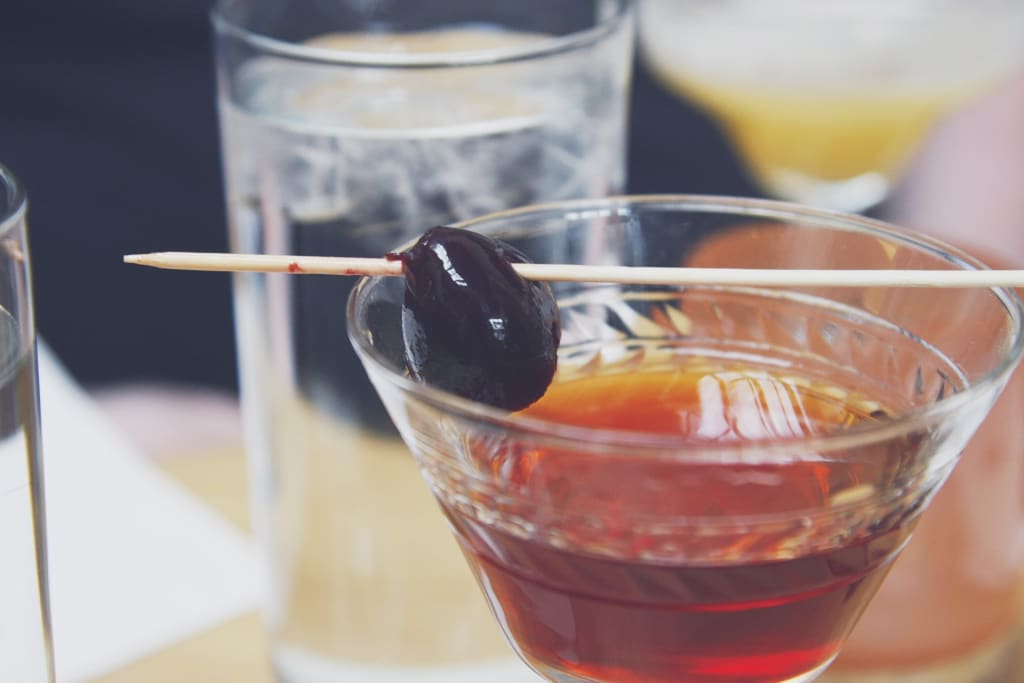What Makes a Manhattan a Manhattan?
Subtle alterations can separate one cocktail from something completely different.

There are approximately 12 million Google results for "Manhattan recipe." Every major food website and cocktail blog offers their take, and each of these recipes is ever so slightly different.
Chowhound calls for a simple 2:1 whiskey-to-vermouth ratio, allowing for the use of either bourbon or rye. Epicurious suggests 2½ ounces of rye to a half-ounce vermouth, and goes for one dash each Angostura and orange bitters. Bon Appétit recommends building the drink over ice in the glass, specifies bourbon, and calls for the bartender to “crush [the cherry] against the side of the glass with a spoon” before stirring.
No recipe is without variations. Every chef or bartender (and every diner or drinker, for that matter) has their own tastes. But especially with cocktails, subtle differences can often create a whole new drink.
Case in point: based on a cursory scan of the first six million Manhattan recipes on Google, it’s safe to assume that most bartenders will still consider a Manhattan a Manhattan whether it’s made with bourbon, rye, or even Canadian whiskey (a common substitute during Prohibition when the traditional Southern-made rye was unavailable). But if you use scotch, you’ve unquestionably got yourself a Rob Roy.
One could argue that the smoke and peat makes the scotch different enough from American or Canadian whiskey to constitute another drink altogether. But by the same token, I’ve tasted peppery, spicy ryes that have almost nothing in common with some tooth-achingly sweet bourbons. So why should we draw the line at scotch? What separates one cocktail from another, closely related drink?
Here’s yet another wrinkle: the explosion of the craft cocktail scene has resulted in a glut of new cocktail recipes designed by talented and highly particular slingers of spirits. The signature drinks at a place like Backbar in Somerville, MA, or Spilt Milk Tavern in Chicago are often crafted with the unique flavor profiles of specific bottlings in mind. If you were to make one of these drinks with the same proportions and method but using different brands, could you still call it the same drink?
Perhaps it isn’t so much what goes into a drink that makes it unique as what you get out of it — the flavor and mouthfeel of the cocktail. You don’t have to know whether a bartender used 2.5:1 or 2:1 or 2:0.5 whiskey-to-vermouth. Instead, like pornography, you simply know a Manhattan when you see it — or taste it, as the case may be.
(This theory gets amusing if you consider the origin story of the Jasmine cocktail: when creator Paul Harrington first served the drink to the man who had requested it, the patron reportedly exclaimed, “Wow, that’s good. You just invented grapefruit juice.” By our logic, the Jasmine ought to be simply called Grapefruit Juice.)
Making a cocktail, then, must have more to do with creating a commonly agreed-upon drinking experience than strictly following a recipe. Depending on her choice of whiskey and vermouth, a skilled bartender will adjust the proportions and preparation to ensure that the drinker can say immediately upon taking the first sip, “That’s a Manhattan.”
Ultimately, a cocktail deserves its appellation if both the bartender and the drinker can agree that it meets their expected standards for what that particular drink ought to be. A drink is not, then, just the product of a recipe. It is more like a Platonic ideal or an unspoken social grace that depends on tradition, experience, and even a tiny bit of magical thinking to come into its identity.
About the Creator
Connor Saparoff Ferguson
Writer, translator, and cocktail wonk based in Boston. Bylines in The Millions, The Rumpus, Electric Literature, Hobart, and elsewhere. Twitter: @csferguson






Comments
There are no comments for this story
Be the first to respond and start the conversation.